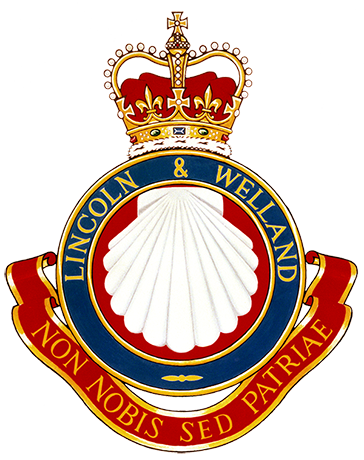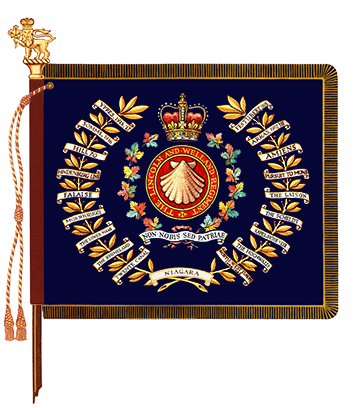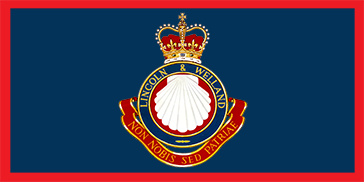The Lincoln and Welland Regiment
The official lineage of The Lincoln and Welland Regiment infantry regiment.

Colonel-in-Chief: Her Royal Highness The Countess of Wessex
Badge
Description
Gules an escallop Argent all within an annulus Azure edged and inscribed LINCOLN and WELLAND in letters Or ensigned by the Royal Crown proper and resting upon a scroll Gules edged and inscribed with the Motto in letters Or.
Symbolism
The crown represents service to the Sovereign. The design commemorates the former units which were amalgamated in 1936 to form the regiment. The general outline of the badge is derived from the badge of The Lincoln Regiment and the escallop, an emblem used by the former County of Welland, is from the badge of The Lincoln and Welland Regiment. "LINCOLN and WELLAND" is a form of the regimental title and "NON NOBIS SED PATRIAE" is the motto of the regiment.
Motto
NON NOBIS SED PATRIÆ (Not for us but for our country)
March
"The Lincolnshire Poacher"
Alliance
British Army
The Royal Anglian Regiment and The Rifles
Regimental colour

Camp flag

Battle honours
The War of 1812
DEFENCE OF CANADA – 1812-1815 – DÉFENSE DU CANADA; DETROIT; QUEENSTON; NIAGARA
The First World War
YPRES, 1915, '17; FESTUBERT, 1915; SOMME, 1916; ARRAS, 1917, '18; HILL 70; AMIENS; HINDENBURG LINE; PURSUIT TO MONS.
The Second World War
FALAISE; Falaise Road; The Laison; Chambois; The Seine, 1944; Moerbrugge; THE SCHELDT; Breskens Pocket; The Lower Maas; Kapelsche Veer; THE RHINELAND; The Hochwald; Veen; Twente Canal; Friesoythe; Küsten Canal; Bad Zwischenahn; NORTH-WEST EUROPE, 1944-1945.
South-West Asia
AFGHANISTAN
Lineage
This Reserve Force regiment originated on 18 March 1863 and incorporates the following regiments.
The Lincoln and Welland Regiment originated in St. Catharines, Ontario on 18 March 1863, when 'The 19th Battalion Volunteer Militia (Infantry), Canada' was authorized to be formed.Footnote 1 It was redesignated: '19th "Lincoln Battalion of Infantry"' on 28 September 1866;Footnote 2 '19th St. Catharines Battalion of Infantry' on 1 October 1897;Footnote 3 '19th St. Catharines Regiment' on 8 May 1900;Footnote 4 '19th "Lincoln" Regiment' on 2 November 1912;Footnote 5 and 'The Lincoln Regiment' on 1 May 1920.Footnote 6 On 15 December 1936, it was amalgamated with 'The Lincoln and Welland Regiment' (see below) and redesignated 'The Lincoln and Welland Regiment'.Footnote 7 It was redesignated: '2nd (Reserve) Battalion, The Lincoln and Welland Regiment' on 7 November 1940;Footnote 8 and 'The Lincoln and Welland Regiment' on 15 February 1946.Footnote 9
Notes:
Upon redesignation as The Lincoln Regiment on 1 May 1920 (see above), it was organized as a two battalion regiment with the 1st Battalion (81st Battalion, CEF) on the Non Permanent Active Militia order of battle, and the 2nd Battalion (176th Battalion, CEF) on the Reserve order of battle. The reserve unit was disbanded on 14 December 1936 (GO 3/37).
The Lincoln Regiment was disbanded for the purpose of reorganization on 1 October 1920 and reorganized the same day (GO 95/21). This change was administrative and does not affect the lineage of the regiment.
The Lincoln Regiment was disbanded for the purpose of amalgamation on 14 December 1936 and reorganized the next day (GO 189/36). This change was administrative and does not affect the lineage of the regiment.
The Lincoln and Welland Regiment originated in Clifton, Ontario on 16 November 1866, when the '44th "Welland" Battalion of Infantry' was authorized to be formed.Footnote 10 It was redesignated: '44th Lincoln and Welland Battalion of Infantry' on 1 October 1897;Footnote 11 '44th Lincoln and Welland Regiment' on 8 May 1900;Footnote 12 and 'The Lincoln and Welland Regiment' on 1 May 1920.Footnote 13 On 15 December 1936, it was amalgamated with 'The Lincoln Regiment', as above.
Notes:
Upon redesignation as The Lincoln and Welland Regiment on 1 May 1920 (see above), it was organized as a two battalion regiment with the 1st Battalion (98th Battalion, CEF) on the Non Permanent Active Militia order of battle, and the 2nd Battalion (no CEF designation) on the Reserve order of battle. The reserve unit was disbanded on 14 December 1936 (GO 3/37).
The Lincoln and Welland Regiment was disbanded for the purpose of reorganization on 15 October 1920 and reorganized the same day (GO 232/20). This change was administrative and does not affect the lineage of the regiment.
The Lincoln and Welland Regiment was disbanded for the purpose of amalgamation on 14 December 1936 and reorganized the next day (GO 189/36). This change was administrative and does not affect the lineage of the regiment.
Perpetuations
‘Battalion of Incorporated Militia of Upper Canada’, ‘The Coloured Corps (Captain Runchey’s Company of Coloured Men)’, ‘1st, 2nd, 3rd, 4th, and 5th Regiments of Lincoln Militia (1812-15)’, '81st', '98th' and '176th "Overseas" Battalion(s), CEF'
Headquarters Location
St. Catharines, Ontario
Operational history
The Fenian Raids
The 19th Battalion Volunteer Militia (Infantry), Canada was called out on active service on 1 June 1866. The battalion served on the Niagara frontier and was removed from active service on 22 June 1866.Footnote 14
The 19th "Lincoln" Battalion of Infantry was called out on active service on 24 May 1870. The battalion served on the Niagara frontier and was removed from active service on 3 June 1870.Footnote 15
The First World War
The 19th "Lincoln" Regiment was placed on active service on 6 August 1914 for local protection duties with the Welland Canal Force.Footnote 16
The 44th Lincoln and Welland Regiment was placed on active service on 6 August 1914 for local protection duties with the Welland Canal Force.Footnote 17
The 81st Battalion, which was authorized on 10 July 1915 as the '81st "Overseas" Battalion, CEF',Footnote 18 embarked for Britain on 28 April 1916.Footnote 19 The battalion provided reinforcements to the Canadian Corps in the field until 6 July 1916, when its personnel were absorbed by the '35th Reserve Battalion, CEF'.Footnote 20 The battalion was disbanded on 27 July 1917.Footnote 21
The 98th Battalion, which was authorized on 22 December 1915 as the '98th "Overseas" Battalion, CEF',Footnote 22 embarked for Britain on 16 July 1916.Footnote 23 The battalion provided reinforcements to the Canadian Corps in the field until 6 October 1916, when its personnel were absorbed by the '12th Reserve Battalion, CEF'.Footnote 24 The battalion was disbanded on 17 July 1917.Footnote 25
The 176th Battalion, which was authorized on 15 July 1916 as the '176th "Overseas" Battalion, CEF',Footnote 26 embarked for Britain on 29 April 1917.Footnote 27 On 9 May 1917, its personnel were absorbed by the '12th Reserve Battalion, CEF' to provide reinforcements to the Canadian Corps in the field.Footnote 28 The battalion was disbanded on 30 August 1920.Footnote 29
The Second World War
The regiment was called out on service on 26 August 1939 and then details were placed on active service on 1 September 1939, under the designation 'The Lincoln and Welland Regiment, CASF (Details)', for local protection duties.Footnote 30 The details were formed as an active service battalion and designated 'The Lincoln and Welland Regiment, CASF' on 15 August 1940.Footnote 31 It was redesignated the '1st Battalion, The Lincoln and Welland Regiment, CASF' on 7 November 1940.Footnote 32 The unit served in British Columbia, as part of the 13th Infantry Brigade, and in Newfoundland in a home defence role as part of Atlantic Command.Footnote 33 On 16 July 1943 it embarked for Britain.Footnote 34 On 25 July 1944, the battalion landed in France as a part of the 10th Infantry Brigade, 4th Canadian Armoured Division, and it continued to fight in North West Europe until the end of the war.Footnote 35 The overseas battalion was disbanded on 15 February 1946.Footnote 36
South-West Asia
From 2002 to 2014, the Lincoln and Welland Regiment reinforced various CAF units deployed to Afghanistan.Footnote 37
Page details
- Date modified: